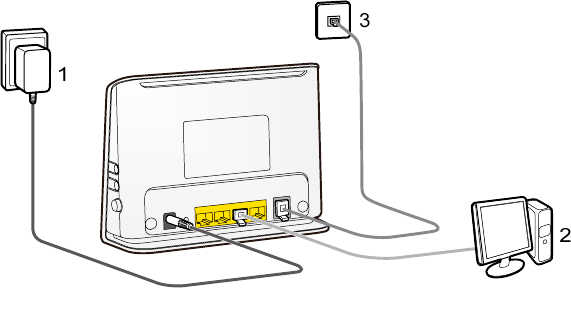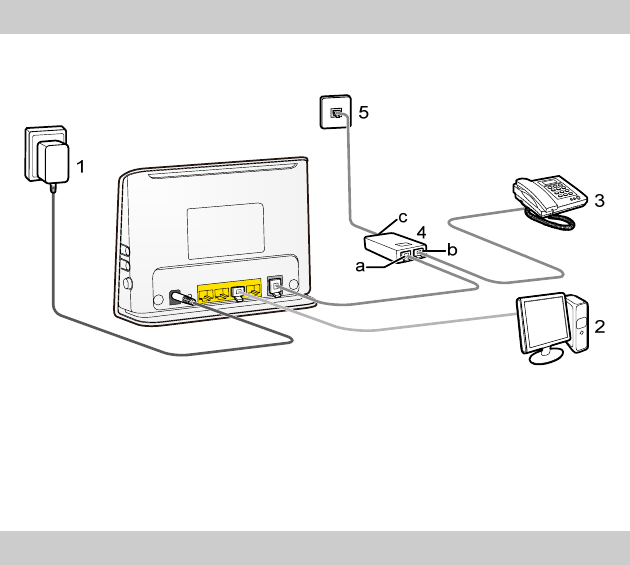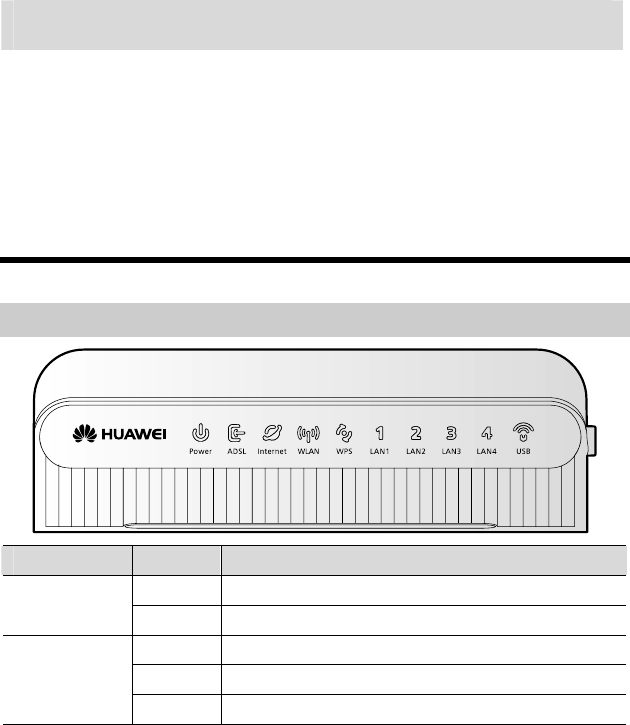Huawei Technologies HG532C Home Gateway User Manual
Huawei Technologies Co.,Ltd Home Gateway
user manual

HUAWEI HG532c Home Gateway
User Guide
HUAWEI TECHNOLOGIES CO., LTD.

HUAWEI HG532c Home Gateway
V100R001
User Guide
Issue 01
Date 2010-07-09
Part Number 202263
Huawei Technologies Co., Ltd. provides customers with comprehensive
technical support and service. Please feel free to contact our local office
or company headquarters.
Huawei Technologies Co., Ltd.
Address: Huawei Industrial Base
Bantian, Longgang
Shenzhen 518129
People's Republic of China
Website: http://www.huawei.com
Email: terminal@huawei.com

Copyright © Huawei Technologies Co., Ltd. 2010. All
rights reserved.
No part of this document may be reproduced or transmitted in any form or by any means
without prior written consent of Huawei Technologies Co., Ltd.
The product described in this manual may include copyrighted software of Huawei
Technologies Co., Ltd and possible licensors. Customers shall not in any manner
reproduce, distribute, modify, decompile, disassemble, decrypt, extract, reverse
engineer, lease, assign, or sublicense the said software, unless such restrictions are
prohibited by applicable laws or such actions are approved by respective copyright
holders under licenses.
Trademarks and Permissions
, , and
are trademarks or registered trademarks of Huawei
Technologies Co., Ltd.
Other trademarks, product, service and company names mentioned are the property of
their respective owners.
Notice
Some features of the product and its accessories described herein rely on the software
installed, capacities and settings of local network, and may not be activated or may be
limited by local network operators or network service providers. Thus the descriptions
herein may not exactly match the product or its accessories you purchase.
Huawei Technologies Co., Ltd reserves the right to change or modify any information or
specifications contained in this manual without prior notice or obligation.
NO WARRANTY
THE CONTENTS OF THIS MANUAL ARE PROVIDED “AS IS”. EXCEPT AS
REQUIRED BY APPLICABLE LAWS, NO WARRANTIES OF ANY KIND, EITHER
EXPRESS OR IMPLIED, INCLUDING BUT NOT LIMITED TO, THE IMPLIED
WARRANTIES OF MERCHANTABILITY AND FITNESS FOR A PARTICULAR
PURPOSE, ARE MADE IN RELATION TO THE ACCURACY, RELIABILITY OR
CONTENTS OF THIS MANUAL.
TO THE MAXIMUM EXTENT PERMITTED BY APPLICABLE LAW, IN NO CASE
SHALL HUAWEI TECHNOLOGIES CO., LTD BE LIABLE FOR ANY SPECIAL,
INCIDENTAL, INDIRECT, OR CONSEQUENTIAL DAMAGES, OR LOST PROFITS,
BUSINESS, REVENUE, DATA, GOODWILL OR ANTICIPATED SAVINGS.
Import and Export Regulations
Customers shall comply with all applicable export or import laws and regulations and will
obtain all necessary governmental permits and licenses in order to export, re-export or
import the product mentioned in this manual including the software and technical data
therein.
Contents
1 Warnings and Precautions ....................................................................... 1
2 Connecting the Cables and Getting Started............................................ 6
2.1 Simple Connection.......................................................................................6
2.2 Connecting One Telephone ..........................................................................8
2.3 Getting Started .............................................................................................8
3 Setting the Network-Access Parameters ................................................. 9
3.1 Configuring the HSPA uplink ......................................................................9
3.2 Configuring the ADSL uplink....................................................................10
Accessing the Network Through the Embedded PPP Dial-Up Software on
the HG532c ..............................................................................................10
Accessing the Network Through the PPP Dial-Up Software on Your
Computer..................................................................................................10
4 Configuring the Wireless Network Connection.................................... 12
Setting Up a Wireless Connection Through the WPS Button...................12
Setting Up a Wireless Connection Manually............................................13
5 Configuring the HG532c......................................................................... 14
5.1 Changing the Administrator Password Used for Logging In to the
Web-Based Configuration Utility......................................................................14
5.2 Enabling or Disabling the Wireless Network Function..............................15
5.3 Changing the Wireless Network Name and the Access Password .............15
5.4 Setting Up a Wireless Connection Through the WPS Protocol..................16
i
5.5 Changing the IP Address Used for Logging In to the Web-Based
Configuration Utility .........................................................................................17
5.6 Restoring Default Settings..........................................................................17
6 FAQs......................................................................................................... 18
7 Appendix.................................................................................................. 21
7.1 Indicators....................................................................................................21
7.2 Interfaces and Buttons................................................................................23
7.3 Default Settings..........................................................................................24
7.4 Technical Specifications.............................................................................24
ii

1 Warnings and Precautions
Thank you for purchasing the HUAWEI HG532c Home Gateway (hereinafter referred
to as the HG532c).
To use the device properly and safely, read these warnings and precautions carefully
and strictly observe them during operation. Unless otherwise specified, the term
"device" refers to the device and its accessories.
Basic Requirements
z During storage, transportation, and operation of the device, keep it dry and prevent
it from colliding with other objects.
z Do not dismantle the device. In case of any fault, contact an authorized service
center for assistance or repair.
z Without authorization, no organization or individual can change the mechanical,
safety, or performance design of the device.
z When using the device, observe all applicable laws and regulations and respect the
legal rights of other people.
Environmental Requirements for Using the Device
z Before connecting and disconnecting cables, stop using the device, and then
disconnect it from the power supply. Ensure that your hands are dry during
operation.
z Keep the device far from sources of heat and fire, such as a heater or a candle.
z Keep the device far from electronic appliances that generate strong magnetic or
electric fields, such as a microwave oven or a refrigerator.
z Place the device on a stable surface.
z Place the device in a cool and well-ventilated indoor area. Do not expose the device
to direct sunlight.
z Use the device in an area with a temperature ranging from 0°C to 40°C.
z Do not block the openings on the device with any object. Reserve a minimum space
of 10 cm around the device for heat dissipation.
z Do not place any object (such as a candle or a water container) on the device. If any
foreign object or liquid enters the device, stop using the device immediately, power
it off, remove all the cables connected to it, and then contact an authorized service
center.
1
z During thunderstorms, power off the device, and then remove all the cables
connected to it to prevent it from getting damaged due to lightning strikes.
Precautions for Using Wireless Devices
z When using the device, ensure that the antenna of the device is at least 20 cm away
from all persons.
z Do not use the device where using wireless devices is prohibited or may cause
interference or danger.
z The radio waves generated by the device may interfere with the operation of
electronic medical devices. If you are using any electrical medical device, contact
its manufacturer for the restrictions on the use of the device.
z Do not take the device into operating rooms, intensive care units (ICUs), or
coronary care units (CCUs).
Areas with Inflammables and Explosives
z Do not use the device where inflammables or explosives are stored, for example, in
a gas station, oil depot, or chemical plant. Otherwise, explosions or fires may occur.
In addition, follow the instructions indicated in text or symbols.
z Do not store or transport the device in the same box as inflammable liquids, gases,
or explosives.
Accessory Requirements
z Use only the accessories supplied or authorized by the device manufacturer.
Otherwise, the performance of the device may get affected, the warranty for the
device or the laws and regulations related to telecommunications terminals may
become null and void, or an injury may occur.
z Do not use the power adapter if its cable is damaged. Otherwise, electric shocks or
fires may occur.
z Ensure that the power adapter meets the specifications indicated on the device
nameplate.
z Ensure that the power adapter meets the requirements of Clause 2.5 in
IEC60950-1/EN60950-1 and it is tested and approved according to national or local
standards.
Safety of Children
Keep the device and its accessories out of the reach of children. Otherwise, they
may damage the device and its accessories by mistake, or they may swallow the
small components of the device, causing suffocation or other dangerous situations.
2

Maintenance
z If the device is not used for a long time, power it off, and then remove all the cables
connected to it.
z If any exception occurs, for example, if the device emits any smoke or unusual
sound or smell, stop using the device immediately, power it off, remove all the
cables connected to it, and then contact an authorized service center.
z Do not trample, pull, or overbend any cable. Otherwise, the cable may get damaged,
causing malfunction of the device.
z Before cleaning the device, stop using it, power it off, and then remove all the
cables connected to it.
z Use a clean, soft, and dry cloth to clean the device shell. Do not use any cleaning
agent or spray to clean the device shell.
Disposal and Recycling Information
This symbol on the device (and any included batteries) indicates that the device (and
any included batteries) should not be disposed of as normal household garbage. Do not
dispose of your device or batteries as unsorted municipal waste. The device (and any
batteries) should be handed over to a certified collection point for recycling or proper
disposal at the end of its life.
For more detailed information about the recycling of the device or batteries, contact
your local city office, the household waste disposal service, or the retail store where you
purchased this device.
The disposal of this device is subject to the Waste from Electrical and Electronic
Equipment (WEEE) Directive of the European Union. The purpose for separating
WEEE and batteries from other waste is to minimize any environmental impact and
health hazard due to the presence of hazardous substances.
Reduction of Hazardous Substances
This device is compliant with the EU Registration, Evaluation, Authorisation and
Restriction of Chemicals (REACH) Regulation (Regulation No 1907/2006/EC of the
European Parliament and of the Council) and the EU Restriction of Hazardous
Substances (RoHS) Directive (Directive 2002/95/EC of the European Parliament and
of the Council). For more information about the REACH compliance of the device,
3
visit the Web site www.huaweidevice.com/certification. You are recommended to visit
the Web site regularly for up-to-date information.
EU Regulatory Conformance
This device should be installed and operated with a minimum distance of 20 cm
between the antenna and all persons.
Български: С настоящето Huawei Technologies Co., Ltd. декларира, че
този уред съответства на основните изисквания и другите разпоредби на
Директива 1999/5/EC.
Česky: Huawei Technologies Co., Ltd., tímto prohlašuje, že toto zařízení je ve shodě se
základními požadavky a dalšími souvisejícími opatřeními směrnice 1999/5/EC.
Dansk: Huawei Technologies Co., Ltd. erklærer hermed at denne enhed er i
overensstemmelse med de obligatoriske krav og andre relevante bestemmelser i
direktiv 1999/5/EF.
Nederlands: Hierbij verklaart Huawei Technologies Co., Ltd. dat dit apparaat in
overeenstemming is met de essentiële eisen en de andere relevante bepalingen van
richtlijn 1999/5/EC.
English: Hereby, Huawei Technologies Co., Ltd. declares that this device is in
compliance with the essential requirements and other relevant provisions of Directive
1999/5/EC.
Eesti: Käesolevaga kinnitab Huawei Technologies Co., Ltd., et see seade vastab
Direktiivi 1999/5/EÜ põhinõudmistele ja teistele asjakohastele määrustele.
Suomi: Huawei Technologies Co., Ltd. vakuuttaa täten, että tämä laite on
yhdenmukainen direktiivin 1999/5/EY olennaisten vaatimusten ja direktiivin muiden
asiaankuuluvien lausumien kanssa.
Français (Européen) : Le fabricant déclare que ce produit est conforme aux exigences
essentielles et aux autres dispositions pertinentes de la directive 1999/5/CE.
Deutsch: Huawei Technologies Co., Ltd. erklärt hiermit, dass dieses Produkt die
erforderlichen Bestimmungen und andere relevante Verordnungen der Richtlinie
1999/5/EG einhält.
Ελληνικά: Δια της παρούσης η Huawei Technologies Co., Ltd. δηλώνει ότι αυτή η
συσκευή συμμορφώνεται με τις βασικές απαιτήσεις και άλλες σχετικές διατάξεις της
οδηγίας 1999/5/Ε.Κ.
Magyar: Jelen nyilatkozaton keresztül a Huawei Technologies Co., Ltd. kijelenti, hogy
a készülék megfelel az EC/5/1999 Irányelv összes lényeges követelményének és
vonatkozó előírásának.
Gaeilge: Fograíonn Huawei Technologies Co., Ltd leis seo go bhfuil an fheiste seo i
gcomhlíonadh leis na fíor-riachtanais agus na forálacha eile maidir le Treoir
1999/5/AE.
4

Italiano: Col presente documento, Huawei Technologies Co., Ltd. dichiara che questo
dispositivo è conforme ai requisiti essenziali e alle altre disposizioni applicabili della
Direttiva 1999/5/CE.
Latviski: Ar šo Huawei Technologies Co., Ltd. paziņo, ka šī ierīce atbilst Direktīvas
1999/5/EC pamatprasībām un piemērojamajiem nosacījumiem.
Lietuviškai: Šiuo Huawei Technologies Co., Ltd. praneša, kad šis įtaisas atitinka
Direktyvos 1999/5/EC pagrindinius reikalavimus ir taikomas sąlygas.
Malti: Hawnhekk, Huawei Technologies Co., Ltd. tiddikjara li dan it-tagħmir hu
konformi mal-ħtiġijiet essenzjali u provvedimenti rilevanti oħrajn ta’ Direttiva
1999/5/KE.
Polski: Wymieniona w tym dokumencie firma Huawei Technologies Co., Ltd.
deklaruje, że niniejsze urządzenie spełnia zasadnicze wymagania w zakresie zgodności
oraz inne odnośne postanowienia Dyrektywy 1999/5/EC.
Português (Europeu) : Deste modo, a Huawei Technologies Co., Ltd. declara que este
dispositivo está em conformidade com os requisitos essenciais e outras provisões
relevantes da Directiva 1999/5/CE.
Română: Prin prezenta Huawei Technologies Co., Ltd. declară că acest dispozitiv este
conform cu cerinţele esenţiale şi alte prevederi relevante ale directivei 1999/5/CE.
Slovenčina: Huawei Technologies Co., Ltd. týmto vyhlasuje, že zariadenie je v súlade
so základnými požiadavkami a inými relevantnými predpismi Smernice 1999/5/ES.
Slovenščina: Huawei Technologies Co., Ltd. izjavlja, da je ta naprava v skladu z
bistvenimi zahtevami in drugimi ustreznimi določbami Direktive 1999/5/ES.
Español (Europeo) : Con el presente documento, Huawei Technologies Co., Ltd.
declara que este dispositivo cumple con los requisitos esenciales y con las demás
disposiciones correspondientes de la Directiva 1999/5/CE.
Svenska: Huawei Technologies Co., Ltd. förklarar härmed att denna produkt
överensstämmer med de grundläggande kraven och andra relevanta föreskrifter i
direktiv 1999/5/EG.
For the declaration of conformity, visit the Web site
www.huaweidevice.com/certification.
Notice: This device can be operated in all European countries.
France: Outdoor use limited to 10 mW e.i.r.p. within the band 2454-2483.5 MHz.
Italy: For private use, a general authorisation is required if WAS/RLAN's are used
outside own premises. For public use, a general authorisation is required.
Luxembourg: General authorisation required for network and service supply.
5

Norway: This subsection does not apply for the geographical area within a radius of 20
km from the centre of Ny-Ålesund.
Federal Communications Commission (FCC) Statement
This device complies with part 15 of the FCC Rules. Operation is subject to the
following two conditions: (1) This device may not cause harmful interference, and (2)
this device must accept any interference received, including interference that may cause
undesired operation.
This device complies with part 68 of the FCC Rules.
This device should be installed and operated with a minimum distance of 20 cm
between the antenna and all persons.
Note: This equipment has been tested and found to comply with the limits for a Class B
digital device, pursuant to part 15 of the FCC Rules. These limits are designed to
provide reasonable protection against harmful interference in a residential installation.
This equipment generates, uses and can radiate radio frequency energy and, if not
installed and used in accordance with the instructions, may cause harmful interference
to radio communications. However, there is no guarantee that interference will not
occur in a particular installation. If this equipment does cause harmful interference to
radio or television reception, which can be determined by turning the equipment off and
on, the user is encouraged to try to correct the interference by one or more of the
following measures:
z Reorient or relocate the receiving antenna.
z Increase the separation between the equipment and receiver.
z Connect the equipment into an outlet on a circuit different from that to which the
receiver is connected.
z Consult the dealer or an experienced radio/TV technician for help.
Warning: Changes or modifications made to this device not expressly approved by
Huawei Technologies Co., Ltd. may void the FCC authorization to operate this device.
2 Connecting the Cables and Getting
Started
2.1 Simple Connection
If your telephone line is used for the broadband network access only and do not need to
use a telephone, take the following figure as a reference for connecting the cables.
6

1. Telephone jack on the wall 2. Power adapter 3. Computer
7

2.2 Connecting One Telephone
If your telephone line is used for both the broadband network access and a telephone
connection, take the following figure as a reference for connecting the cables.
1. Power adapter 2. Computer 3. Telephone
4. Splitter 5. Telephone jack on the wall
a. MODEM interface b. PHONE interface c. LINE interface
2.3 Getting Started
Press down the ON/OFF button on the side of the HG532c to power on the HG532c.
After you power on the HG532c, the Power indicators turns on and the ADSL indicator
blinks (for less than three minutes), which indicates that the HG532c is being activated.
After the ADSL indicator blinking, the Power and ADSL indicators keep solid on,
which indicates that the HG532c is working properly.
8

3 Setting the Network-Access Parameters
The HG532c supports ADSL2+ uplink and High-Speed Packet Access (HSPA) uplink
through Huawei HSPA data card. Realizes dynamic mutual backup of voice and data
services through the DSL link and HSPA link.
3.1 Configuring the HSPA uplink
When the HG532c is working through Huawei HSPA data card, you need to install the
Huawei HSPA data card on the HG532c so that your PC can connect to the Internet
through HSPA uplink. To create a HSPA uplink connection, do as follows:
Step 1 Log in to the Web-based configuration utility.
1. Launch the Internet Explorer on your computer. Enter http://192.168.1.1
in the address bar, and then press Enter.
2. In the displayed dialog box, enter the user name and the password, and
then click Login.
By default, both the user name and the password are admin. After the user
name and the password are verified, you can access the Web-based
configuration utility.
Step 2 Click Basic > WAN in the navigation tree to display the WAN Connection
Page.
Step 3 Click the connection whose name is ttyUSB0.
Step 4 Select Enable for WAN connection.
Step 5 Enter the APN and the Dial number that are provided by the network operator
in the APN text box and the Dial number text box.
Step 6 Enter the user name and password in the User name and Password text
boxes that you can configure.
Step 7 Click the Submit button to finish the UMTS settings.
If you want to verify the PIN code of your SIM card, then do as follows:
Step 1 Click Advanced > PIN in the navigation tree to display the PIN Page.
Step 2 Enter the original PIN number in the PIN text box.
Step 3 Click the Submit button to finish the settings on the PIN Page.
Use the default values for the other parameters. In general, they do not
need to be configured.
9

3.2 Configuring the ADSL uplink
By configuring the HG532c and your computer, you can choose any of the following
methods to surf the Internet:
z Accessing the Network Through the Embedded PPP Dial-Up Software on the
HG532c
z Accessing the Network Through the PPP Dial-Up Software on Your Computer
Accessing the Network Through the Embedded PPP
Dial-Up Software on the HG532c
If you select this method for accessing the network, the HG532c starts to set up a
dial-up connection automatically after the startup. You can access the network after you
power on your computer. You do not need to install any special dial-up software on
your computer or perform dial-up operations on your computer. To configure the
HG532c and your computer for the network access, do as follows:
Step 1 Verify the HG532c and the PC have connected properly, and the PC has
obtained the IP address.
Step 2 Log in to the Web-based configuration utility of the HG532c.
Step 3 Enable the embedded dial-up function.
1. In the navigation tree on the left of the Web-based configuration utility,
choose Basic > WAN.
2. Select a PVC from the connection list.
3. Select Route from the Connection mode drop-down combo box.
4. Enter the VPI and VCI parameters that are provided by the network
operator in the VPI/VCI text boxes.
5. Select PPPoE from the Connection type drop-down combo box.
6. Enter the user name and password that are provided by the network
operator in the Username and Password text boxes, keep the default
settings of other parameters.
7. Click Submit.
After you complete the preceding settings, you can surf the Internet.
You need to perform the preceding operations on a computer once only. The next time
when you power on your computer, you can surf the Internet without any configuration.
Accessing the Network Through the PPP Dial-Up
Software on Your Computer
If you select this method for accessing the network, you need to install and configure
the dial-up software on your computer. In addition, you need to perform dial-up
10
operations on your computer upon each startup. To configure the HG532c and your
computer for the network access, do as follows:
Step 1 Set the working mode of the HG532c to Bridge.
1. In the navigation tree on the left of the Web-based configuration utility,
choose Basic > WAN.
2. Select a PVC from the connection list.
3. Select Bridge from the Connection mode drop-down combo box.
4. Click Submit.
Step 2 Install and configure the PPP dial-up software on your computer.
The PPP dial-up software is pre-installed on certain computer operating
systems. To create a dial-up connection, do as follows (taking the Windows
XP operating system as an example):
1. Choose Start > All Programs > Accessories > Communications >
Network Connections.
2. Click Create a new connection in Network Tasks to display the New
Connection Wizard window, and then click Next.
3. Select Connect to the Internet, and then click Next.
4. Select Set up my connection manually, and then click Next.
5. Select Connect using a broadband connection that requires a user
name and password, and then click Next.
6. Enter the name (as desired) of the dial-up connection in ISP Name, and
then click Next.
7. Select Anyone's use or My use only, and then click Next.
8. Enter the user name and password provided by the network operator and
used for the dial-up connection, and then click Next.
9. Select Add a shortcut to this connection to my desktop, and then click
Finish.
An icon for the dial-up connection is displayed on the desktop of your computer.
You need to perform the preceding operations only once for creating a network
connection. After the network connection is created, to access the network,
double-click the icon for the dial-up connection, and then click Connect in the
displayed dialog box.
11

4 Configuring the Wireless Network
Connection
If a wireless network adapter is installed on your computer, you can connect you
computer to the HG532c through a wireless connection.
The hardware installation methods and driver installation methods of
wireless network adapters provided by different companies vary from
each other. For details, see the installation guide provided by the
wireless network adapter provider.
Setting Up a Wireless Connection Through the WPS
Button
The HG532c supports the Wi-Fi Protected Setup (WPS) function. If your network
adapter also supports the WPS function, you can use the WPS function to set up a
wireless connection between your PC and the HG532c quickly. To set up a wireless
connection, do as follows:
Step 1 Enable the wireless network function, and set the wireless network name and
access password of the HG532c, do as follows (taking the authentication type
WPA-PSK as an example):
1. Log in to the Web-based configuration utility of the HG532c.
2. In the navigation tree on the left of the Web-based configuration utility,
choose Basic > WLAN.
3. Select the Enable WLAN option.
4. Enter a wireless network name in the SSID text box.
5. Select WPA-PSK from the Security drop-down combo box.
6. Enter an access password in the WPA pre-shared key text box.
7. Select AES from the WPA encryption drop-down combo box.
8. Click Submit to save the settings.
Step 2 Press the WPS button of the HG532c to enable the HG532c to enter the WPS
negotiation state.
Step 3 Enable the WPS negotiation function of the wireless network adapter on your
PC within two minutes, and then wait for a moment (typically 10s and at most
120s).
The WPS indicator of the HG532c becomes on from the blinking state, indicating that
the HG532c is connected to your PC through the WLAN. This state lasts 300s. Then the
WPS indicator turns off.
12

If the WPS indicator does not blink, it indicates that the WPS function
cannot be enabled. Note that the WPS function can be used only when the
wireless network function is enabled and the wireless network security
mode of the WLAN is set to WPA-PSK or WPA2-PSK.
Setting Up a Wireless Connection Manually
If your network adapter does not support the WPS function, you can set up a wireless
connection between your PC and the HG532c manually. To manually set up a wireless
connection, use either of the following methods:
z Use the tool provided by your network adapter
For details, see the user guide of your network adapter.
z Use the wireless configuration software provided by the operating system of your
PC
This section takes Windows XP as an example and describes how to set up a wireless
connection between your PC and the HG532c manually, do as follows:
Step 1 Enable the wireless network function, and set the wireless network name and
access password of the HG532c.
1. Log in to the Web-based configuration utility.
2. In the navigation tree on the left of the Web-based configuration utility,
choose Basic > WLAN.
3. Select the Enable WLAN option.
4. Enter a wireless network name in the SSID text box.
5. Select WPA-PSK from the Security drop-down combo box.
6. Enter an access password in the WPA pre-shared key text box.
7. Select AES from the WPA encryption drop-down combo box.
8. Click Submit to save the settings.
Step 2 Enable the wireless configuration service provided by Windows XP.
1. Right-click My Computer, and then choose Manage from the shortcut
menu.
2. In the Computer Management window, choose Computer
Management (Local) > Services and Applications >Services.
3. From the services listed in the right pane of the Computer Management
window, right-click Wireless Zero Configuration, and then choose
Properties from the shortcut menu.
4. In the Wireless Zero Configuration Properties (Local Computer)
dialog box, check whether Service status is Started. If not, click Start.
5. Click OK to close the dialog box, and then close the Computer
Management window.
Step 3 Configure the wireless network connection on your computer.
13

1. Choose Start > All Programs > Accessories > Communications >
Network Connections.
2. In the Network Connections window, right-click Wireless Network
Connection to display a shortcut menu, and then select View Available
Wireless Networks from the shortcut menu.
3. In the Wireless Network Connection Properties dialog box, select
Wireless Networks.
4. Select Use Windows to configure my wireless network settings.
5. Click View Wireless Networks.
6. In the Wireless Network Connection dialog box, select the WLAN with
the same name that is configured in Step 1, and then click Connect in the
lower right corner of the window.
7. In the displayed dialog box, enter the access password that is preset in
Step 1, and then click Connect.
After the password is authenticated, Connected is displayed in the upper right
corner of the WLAN icon in the WLAN list, indicating that a wireless
connection is set up between you PC and the HG532c.
8. Close the Wireless Network Connection dialog box.
9. In the Wireless Network Connection Properties dialog box, click OK.
5 Configuring the HG532c
5.1 Changing the Administrator Password Used
for Logging In to the Web-Based
Configuration Utility
For safety reasons or to make the password easy to remember, you can change the
administrator password for login after logging in to the Web-based configuration
utility.
To change the password, do as follows:
Step 1 Log in to the Web-based configuration utility.
Step 2 Choose Maintenance > Account in the navigation tree to display the system
management page.
Step 3 Select admin from the User name drop-down combo box.
Step 4 Enter the Current password and the new password. Then enter the new
password again in the Confirm password text box for confirmation.
14

Step 5 Click Submit.
After you change the password successfully, the current page jumps to the page for
logging in to the Web-based configuration utility. To log in to the Web-based
configuration utility, enter the new password, and then click OK.
d
our
customized data is lost. Therefore, use this function with caution.
If you forget the user name or password that has been changed, you can
restore the default settings of the HG532c by pressing and holding the
Reset button for over six seconds. Then, the user name and password that
are used for logging in to the Web-based configuration utility are restore
to default values. After you restore the default settings, however, y
5.2 ng the Wireless Enabling or Disabli
Network Function
You can quickly enable or disable the wireless network function by pressing the
WLAN button on the HG532c. To enable the wireless network function, press and hold
the WLAN button for over one second, and then release the button. You can disable the
wireless network function in the same way. The WLAN indicator shows whether the
onfiguration utility. To enable or disable the wireless network function, do
e left, choose Basic > LAN.
ect Enable WLAN option button.
Cli
wireless network function is enabled.
In addition, you can enable or disable the wireless network function through the
Web-based c
as follows:
Step 1 Log in to the Web-based configuration utility.
Step 2 In the navigation tree on th
Step 3 Choose the WLAN page.
Step 4 Select or not sel
Step 5 ck Submit.
f the WLAN indicator is on, the
wireless network function is enabled.
You can refer to the state of the WLAN indicator to check whether the
wireless network function is enabled. I
5.3 s Network Name and Changing the Wireles
the Access Password
To change the name and access password for the wireless network, do as follows
th ):
(taking e authentication type WPA-PSK as an example
15

Step 1 Log in to the Web-based configuration utility.
.
A pre-shared key text box.
Step 7 Select TKIP from the WPA encryption drop-down combo box.
Step 2 In the navigation tree on the left, choose Basic > LAN
Step 3 Choose the WLAN page.
Step 4 Enter a wireless network name in the SSID text box.
Step 5 Select WPA-PSK from the Security drop-down combo box.
Step 6 Enter an access password in the WP
Step 8 Click Submit to save the settings.
5.4 Setting Up a Wireless Connection Through
the WPS Protocol
The HG532c supports the WPS technology. By using this technology, the HG532c can
connect to a wireless terminal easily and safely. During the connecting process, you do
not need to enter the name and access password of the WLAN network.
To use the WPS function, your wireless network adapter should support the WPS
function. Meanwhile, you need to set the encryption type of the WLAN to WPA-PSK
or WPA2-PSK.
To set up a wireless connection by using a wireless network adapter through the W
do as follows:
PS
protocol,
Step 1
onfiguration utility.
n tree on the left, choose Basic > LAN.
he WPS
function. After a few seconds (normally 10s to 120s), the WPS indicator of the HG532c
turns solid on in orange (this state lasts for 300s), which indicates that the connection
between the HG532c and the wireless network adapter is set up successfully.
Enable the WPS function.
1. Log in to the Web-based c
2. In the navigatio
3. Choose the WLAN page.
4. Select Enable for WPS.
5. Click Submit.
Step 2 Launch the WPS client software of the wireless network adapter of the
computer. Perform operations based on the software user interface to display
the interface of searching for the wireless network.
Step 3 Press the WPS button on the side panel of the HG532c within two minutes.
The WPS indicator of the HG532c blinks in green, which indicates that the connection
between the HG532c and the wireless network adapter is being set up through t
16

The WPS applications may vary with different types of wireless network
adapters. For details about the configuration and operations of the WPS
application, refer to the operation guide provided by the application
provider.
5.5 Changing the IP Address Used for Logging
In to the Web-Based Configuration Utility
To make the login IP address easy to remember, you can change the IP address after
logging in to the Web-based configuration utility.
To change the IP address, do as follows:
Step 1 Log in to the Web-based configuration utility.
Step 2 In the navigation tree on the left, choose Basic > LAN.
Step 3 Choose the DHCP page.
Step 4 Enter a new IP address as desired in the IP address text box. Then, enter a
subnet mask in Subnet mask.
Step 5 Click Submit.
To log in to the Web-based configuration utility after you change the IP
address successfully, you need to launch the Internet Explorer, and then
enter the new IP address in the address bar. Ensure that the IP address of
the computer is in the same network segment as that of the HG532c so
that the computer can access the Web-based configuration utility.
5.6 Restoring Default Settings
After you restore the default settings, your customized data is lost.
Therefore, use this function with caution.
You can quickly restore the default settings of the HG532c by pressing the Reset button
on the rear panel. To restore the default settings, press and hold the Reset button for
over six seconds after the HG532c is powered on, and then release the button.
In addition, you can restore the default settings of the HG532c through the Web-based
configuration utility. To restore the default settings through the Web-based
configuration utility, do as follows:
Step 1 Log in to the Web-based configuration utility.
17

Step 2 In the navigation tree on the left, choose Maintenance > Device.
Step 3 Choose the Reset page.
Step 4 Click the Restore Default Settings button.
After the preceding operations, the current page jumps to the login page. You can log in
to the Web-based configuration utility by entering the default user name and password
that are admin.
6 FAQs
How can I quickly enable or disable the wireless network function?
Press and hold the WLAN button for over one second, and then release the button to
enable or disable the wireless network function. The WLAN indicator shows
whether the wireless network function is enabled.
How can I quickly restore the default settings of the terminal?
To restore the default settings, press and hold the Reset button on the rear panel for
over six seconds after the HG532c is powered on, and then release the button.
What can I do if I cannot access the Internet through the terminal?
Step 1 Check whether the Power indicator on the terminal is solid on.
If the Power indicator is off, perform further checks as follows:
1. Ensure that the terminal is turned on.
2. Ensure that electricity comes from the socket and that the power input
from the socket meets the requirements described on the label of the
terminal power adapter. If the voltage is unsteady, for example, if the
voltage is too high or too low, do not use the terminal. Wait until the
voltage restores to its normal level, and then use the terminal.
3. Ensure that the terminal is properly connected to the socket through
the power adapter.
If the Power indicator is still off, contact an authorized maintenance
center.
Step 2 After powering on the terminal, wait for about three minutes. Then, check
whether the ADSL indicator on the terminal is solid on.
If the ADSL indicator blinks for a long time, perform further checks as
follows:
1. Ensure that telephone lines are properly connected. Pay special
attention to the connections between the telephone lines and the
splitter.
2. Ensure that the terminal or telephone lines are far from the electric
18
appliances that generate strong magnetic or electric fields. Replace
telephone lines when necessary.
If the ADSL indicator still blinks and does not turn solid on, contact your
network operator.
Step 3 Check whether the LAN indicator of the terminal is on.
If the LAN indicator is off, perform further checks as follows:
1. Ensure that the network adapter of the computer is enabled.
2. Ensure that the network cable between the terminal and the computer
is properly connected. Remove and then insert the network cable or
replace the network cable when necessary.
If the LAN indicator is still off, contact an authorized maintenance center.
Step 4 Check whether the driver for the network adapter is properly installed.
Take a computer that runs Windows XP as an example. To check whether
the driver for the network adapter is installed, do as follows:
1. On the desktop, right-click My Computer, and then choose Manage.
2. In the navigation tree of the Computer Management window,
choose Device Manager.
3. In the right pane of the Computer Management window, click
Network adapters to view the information about the network adapter
of the computer.
If no network adapter is found or if a question mark (?) or an exclamation
mark (!) is displayed next to the icon of the network adapter, you can infer
that the driver for the network adapter is not properly installed. In this
case, re-install the driver for the network adapter of the computer.
Step 5 Ensure that you have entered the correct user name and user password that
are required by the PPP dial-up software.
The user name and the user password are provided by your network
operator.
Step 6 Check whether you can use the PPP dial-up software to dial successfully.
If you cannot use the PPP dial-up software to dial successfully, perform
further checks as follows:
1. Stop the PPP dial-up software and then power off the terminal. After
five minutes, power on the terminal, and then use the PPP dial-up
software to dial again.
2. Restore the default settings of the terminal.
If the problem persists, contact your network operator.
Step 7 Check whether the proxy server of the Web browser is correctly
configured. Take the Internet Explorer installed on a computer that runs
Windows XP as an example. To check whether the proxy server of the
19

Web browser is correctly configured, do as follows:
1. Launch the Internet Explorer.
2. Choose Tools > Internet Options.
3. In the Internet Options dialog box, click the Connections tab.
4. In the Local Area Network (LAN) settings group box, click LAN
Settings.
5. In the Proxy server group box of the Local Area Network (LAN)
Settings dialog box, ensure that the Use a proxy server for your
LAN (These settings will not apply to dial-up or VPN
connections). check box is cleared.
Step 8 Try to access multiple Web sites to check whether the terminal can access
these Web sites.
If the terminal still cannot access Web sites, contact your network service provider.
What can I do if Web pages often cannot be displayed during Web page browsing
and can be displayed after the terminal is restarted?
Step 1 Ensure that the terminal and other devices, such as telephones or fax
machines, are connected to telephone lines through a splitter.
For details about how to install a splitter, see the related description in the
manual.
Step 2 Ensure that telephone lines are properly connected.
If the telephone lines are improperly connected, the stability of the
network connection is affected.
Step 3 Check the positions of your terminal and your computer. Ensure that they
are far from electric appliances, such as microwave ovens, refrigerators,
or cordless telephones, that generate strong magnetic or electric fields.
If the problem persists, contact your service provider.
What can I do if sometimes the terminal cannot access the Internet through a WLAN
connection or if the WLAN connection is unsteady?
Step 1 Check the positions of your terminal and your computer. Ensure that they
are far from the electric appliances, such as microwave ovens,
refrigerators, or cordless telephones, that generate strong magnetic or
electric fields.
Step 2 Place your terminal in an open area.
Although radio signals can pass through obstacles, the transmission
effects of WLAN radio signals are affected if radio signals pass through
too many obstacles, such as cement or wooden walls.
Step 3 Place your computer close to your terminal.
20

If your computer is far from your terminal, the effects of the WLAN are
affected.
Step 4 Place your terminal and computer in another direction.
Step 5 Do not use your terminal to access the WLAN during thunderstorms.
After a broadband terminal is installed, does Internet access degrade call quality or
do telephone calls lower the Internet access rate?
No. The terminal uses the frequency division multiplexing (FDM) and splitter
technologies to separate voice signals from data signals. Although the two types of
signals are transmitted through one telephone line, they are carried by different
frequency bands. Therefore, they do not interfere with each other. In this case, you
can make a telephone call and access the Internet simultaneously, without degrading
call quality or lowering the Internet access rate.
7 Appendix
7.1 Indicators
Indicator Status Description
On The HG532c is powered on. Power
Off The HG532c is powered off.
Blinking The HG532c is being activated.
On The HG532c is activated.
ADSL
Off The HG532c is powered off.
21

Indicator Status Description
Blinking Data is being transmitted.
On z The dial-up operation through the embedded PPP
dial-up function of the HG532c succeeded, but no
data is being transmitted.
z The HG532c works in routing mode.
z The WAN connection is set up.
z No data is being transmitted.
Internet
Off The HG532c is working in bridging mode or the
dial-up operation through the embedded PPP dial-up
function of the HG532c failed.
Blinking z The wireless network function is enabled.
z Data is being transmitted through the WLAN.
On z The wireless network function is enabled.
z No data is being transmitted through the WLAN.
WLAN
Off The wireless network function is disabled.
Blinking The HG532c is attempting to set up a wireless
connection with a wireless client (such as a PC on
which a wireless network adapter is installed) through
the WPS function.
This state lasts no more than 120s.
On A wireless connection is set up between the HG532c
and a wireless client through the WPS function.
This state lasts 300s.
WPS
Off The WPS function is disabled.
Blinking Data is being transmitted through the Ethernet
interface.
On The Ethernet connection is set up.
LAN1 – LAN4
Off The Ethernet connection is not set up.
Blinking Data is being transmitted on the USB port.
On The USB port is connected.
USB
Off The USB port is not connected.
22

7.2 Interfaces and Buttons
No. Interface or Button Description
1 WPS It is used to set up a wireless connection between
the HG532c and a wireless terminal easily and
safely.
2 WLAN It is used to enable or disable wireless network
function quickly.
3 ON/OFF It is the power switch and is used to power on or
power off the HG532c.
4 Power It is used to connect the power adapter.
5 Reset You can press and hold the Reset button for over
six seconds to restore the default settings of the
HG532c.
Note
After you restore the default settings, your customized
data is lost. Therefore, use this function with caution.
6 - 9 LAN1 – LAN4 It is used to connect to the Ethernet interface on
the computer.
10 ADSL It is used to connect to the MODEM interface on
the splitter.
11 USB It is used to connect the USB device.
23

7.3 Default Settings
Parameter Setting
IP address of the LAN interface 192.168.1.1
Subnet mask of the LAN interface 255.255.255.0
User name used for logging in to the Web-based
configuration utility
admin
Password used for logging in to the Web-based
configuration utility
admin
DHCP server function Enable
Wireless network function Enable
7.4 Technical Specifications
Item Specification
Power supply 12 V DC, 1 A
Power consumption < 11 W
Ambient
temperature for
operation
0°C to 40°C (32°F to 104°F)
Ambient humidity
for operation
5% to 95%, non-condensing
Dimensions
(L × W × H)
156.4 mm ×52 mm×124.3 mm
Weight About 245 g
ADSL standards z ITU G.992.1 (G.dmt) Annex A
z ITU G.992.2 (G.lite)
z ITU G.994.1 (G.hs)
z ANSI T1.413 Issue 2
ADSL2 standard ITU G.992.3 (G.dmt.bis) Annex A
ADSL2+
standard
ITU G.992.5 Annex A
Standards
WLAN standard 802.11b, 802.11g, 802.11n
24

Item Specification
G.dmt
T1.413
z Maximum downlink rate: 8 Mbit/s
z Maximum uplink rate: 896 kbit/s
DSL transmission
rates
G.992.5
(ADSL2+)
z Maximum downlink rate: 24
Mbit/s
z Maximum uplink rate: 1024 kbit/s
802.11b 1 Mbit/s, 2 Mbit/s, 5.5 Mbit/s, and 11
Mbit/s
802.11g 6 Mbit/s, 9 Mbit/s, 12 Mbit/s, 18
Mbit/s, 24 Mbit/s, 36 Mbit/s, 48 Mbit/s,
54 Mbit/s
Wireless
transmission rates
802.11n 6.5 Mbit/s, 13.0 Mbit/s, 13.5 Mbit/s,
19.5 Mbit/s, 26.0 Mbit/s, 27.0 Mbit/s,
39.0 Mbit/s, 40.5 Mbit/s, 52.0 Mbit/s,
54.0 Mbit/s, 58.5 Mbit/s, 65.0 Mbit/s,
78.0 Mbit/s, 81.0 Mbit/s, 104.0 Mbit/s,
108.0 Mbit/s, 117.0 Mbit/s, 121.5
Mbit/s, 130.0 Mbit/s, 135.0 Mbit/s,
162.0 Mbit/s, 216.0 Mbit/s, 243.0
Mbit/s, 270.0 Mbit/s, 300.0 Mbit/s
25
HUAWEI TECHNOLOGIES CO., LTD.
Huawei Industrial Base
Bantian, Longgang
Shenzhen 518129
People's Republic of China
www.huawei.com
Part Number: 202263